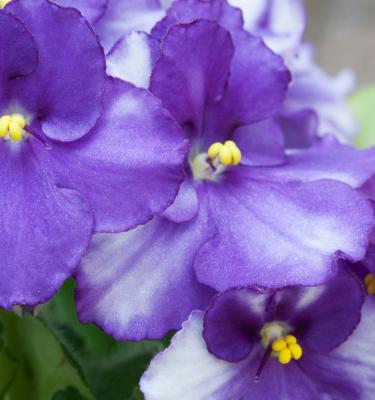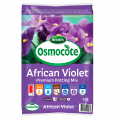

How to Grow & Care for African Violet
Cheerful, bright and compact, African violets are the perfect indoor pot plant. They have eye-catching purple, red, pink or white flowers, and bright yellow anthers at the centre of the petals. With thick, deep green leaves that are soft and have a furry texture, they offer so much for such a small plant.
Top five steps to growing African Violet
African Violets have a reputation for being challenging to grow, but with the right care are actually really easy. They are usually grown as houseplants, but can be grown outdoors in the very northern parts of Australia.
- Replicate the tropical climate from where they originate. Also known as Saintpaulia, Saintpaulia ionantha, or Streptocarpus sect. Saintpaulia, they are native to East Africa, and will thrive when given the same humid growing conditions.
- Choose the shape, or habit, which best suits the place it will grow in. All African Violets are low-growing, rarely reaching more than 40 cm (15”) in height and will be either self-supporting (‘rosette’) types, or trailing. Trailing African violets are more suited to hanging baskets or other locations where they can happily cascade over the side of a container.
- Rotate the plant every couple of weeks so that it grows evenly. African violets, like many plants, will head towards the light, so this will help it to grow in a uniform shape.
- Remove brown leaves and dead flowers. This will help to maintain good air circulation around the plant, keep it looking at its most attractive, and encourage new growth.
- Always check the water and light available to the plant. Getting these things right - by following our tips below - will keep the foliage and flowers at their best.
Plant and Place
The Perfect Potting Mix
African violets can be grown from seed. However, we recommend propagating or buying young plants.
Getting the perfect potting mix is really important, and a general all-purpose potting mix will not provide the right growing conditions.
A potting mix specially formulated for African violets will give free drainage whilst retaining the right amount of moisture and nutrients for the plant to access when needed. We like Scotts Osmocote® African Violet & Cyclamen Mix, which is great for planting new and repotting older African violets.
Light
African violets need lots of indirect light, ideally 10 hours or more each day. Avoid putting them in direct sunlight, which can burn their leaves. However make sure they are not in the shade either, as they need some light to provide energy to produce those lovely flowers. A bathroom window is ideal.
Inadequate light levels are the main reason why African violets do not flower as profusely as expected. Getting the light right means they can flower for most of the year.
How to Care for and nurture your African Violet
Water
Water is key for African violet care. Ideally water from below using a saucer as this avoids splashing the leaves, which can cause scorching and grey mould. Allow the water to soak up through the potting mix. But once water has stopped being absorbed, tip the remainder away - do not allow the plant to sit in a pool of water.
Also, don’t allow the soil to dry out, or to become soggy - water regularly with water which is at room temperature or slightly warmed. Cold water straight from the tap can be a little too cold.
Temperature & Humidity
African violets like consistently warm temperatures of 21C / 70F or more all year round, and plenty of humid air. A lack of humidity can cause the leaves to turn yellow, as well as impair their ability to flower.
Feeding
Use a potting mix which contains a fertiliser, such as Scotts Osmocote® African Violet & Cyclamen Mix. This will steadily feed the plant with the correct balance of nutrients.
Alternatively, use an indoor plant liquid feed every two weeks, like Scotts Osmocote Pour+Feed for Indoor Plants. Apply after watering, so that the soil can absorb the fertiliser before any of it evaporates.
How to propagate African Violet
African violets can be propagated from existing plants. This is a low cost, quick and satisfying way of creating more plants. Perhaps you already have an African violet, or have a friend or family member who is happy for you to take a cutting. African violet propagation can be done at any time of the year by following these simple steps:
- Fill a small pot with potting mix. African violets like a small pot in which the roots can touch the sides.
- Make a small hole in the centre of the potting mix.
- Find a leaf at the base of the stem and cut it off using a sharp knife. The leaf should have a petiole (stem) which is about 3-4cm (1-1.5”) long.
- Insert the cutting into potting mix, so that the bottom of the leaf is just in contact with the surface of the soil.
- Water the soil around the cutting, then cover the pot with a clear plastic bag. Stop the plastic bag from touching the leaves by inserting lollipop sticks into the soil.
- Move the pot to a warm location with indirect light, and expect to see a new plant emerge after a month.
For more choice and variety, it’s worth exploring the thousands of African violet cultivars available to buy. There are a wide range of African violet colours available. You also have the option of single, semi-double or double flowers, as well as a choice of smooth or ragged petal edges.
Common pests and diseases with African Violet Plants
A number of common problems can affect African violets, but the good news is that they are all easy to fix. Identifying the problem is the most important step in resolving it.
Why is new growth stunted on my African violet?
Cyclamen mites love fresh new growth which emerges from the centre of an African violet. Leaves and flower buds may be twisted and misshapen and do not develop as expected. Isolate the plant from others so that it does not spread. Remove affected growth, disposing of it carefully and washing your hands after handling to avoid spreading the mites. Spray with warm soapy water, monitor, and repeat treatments as needed.
Thrips can cause the same symptoms and damage. They respond to the same treatment.
Why does my African violet have a sticky residue on the leaves?
Mealybugs and aphids on African violets attacking a plant can leave a sticky, sometimes black, coating on leaves as they feed on the plant and excrete a sugary waste. Use an insecticide suitable for indoor plants, such as Defender™ Pyrethrum Insect Spray, applying regularly until the pest has been eliminated.
What is eating the leaves on my African violet?
Vine weevil can affect most potted plants. Adult vine weevils can eat the foliage, causing holes to appear in green growth. Vine weevil larvae live in the soil, eating the roots and causing leaves to darken and wilt. Remove the pot from the plant, shake over a sheet, remove the pest by hand and destroy. Return the African violet to the pot, and repeat monitoring and removal as needed.
Why does my African violet have grey patches on the leaves?
Botrytis can cause mouldy grey patches to appear on the foliage. This is usually caused by over-crowded and cool or damp conditions. Remove any affected leaves, reduce watering and increase warmth.
Why does my African violet have white powder on the leaves?
Powdery mildew can cause white dots to appear on the plant. Remove any affected leaves and increase air circulation around the plant.
Why does my African violet have brown patches on the leaves?
Direct sunlight can scorch the leaves of a plant. Move the plant to a place where there is less direct sunlight.
Why isn’t my African violet producing flowers?
Lack of light is the main reason African violets can disappoint. They need light to produce energy and flowery growth. Move the plant to a lighter location, although avoiding direct strong sunlight.



